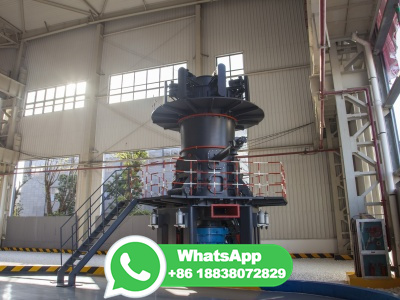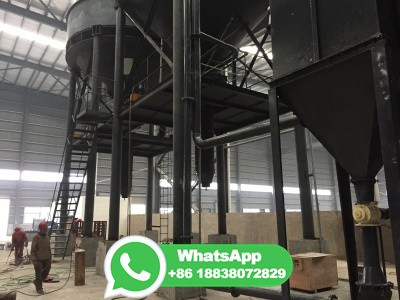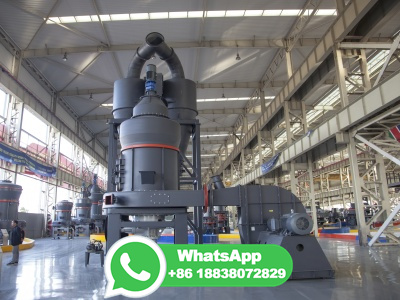
The FischerTropsch process (FT) is a collection of chemical reactions that converts a mixture of carbon monoxide and hydrogen, known as syngas, into liquid reactions occur in the presence of metal catalysts, typically at temperatures of 150300 °C (302572 °F) and pressures of one to several tens of FischerTropsch process is an important reaction ...
WhatsApp: +86 18203695377
Coal can also be liquefied directly, without going through the production of synthesis gas. This process is termed coaltoliquid (CTL) and is a reasonably mature technology. The process typically uses the technique of heating under pressure (up to 470°C, 200 bar) and hydrogenation where hydrogen is added to a coalwater slurry. The slurry ...
WhatsApp: +86 18203695377
Coal gasification technology is the conversion of a carbonaceous material by reaction with oxygen and steam to produce synthesis gas (syngas) that is a feedstock to produce more valuable and higher quality liquid fuels such as diesel and kerosene. During gasification there are hundreds of simultaneous reactions taking place. However, the six principle heterogeneous and homogeneous reactions ...
WhatsApp: +86 18203695377
Synthetic fuel or synfuel is a liquid fuel, or sometimes gaseous fuel, obtained from syngas, a mixture of carbon monoxide and hydrogen, in which the syngas was derived from gasification of solid feedstocks such as coal or biomass or by reforming of natural gas . Common ways for refining synthetic fuels include the FischerTropsch conversion ...
WhatsApp: +86 18203695377
Although currently uses coal rather than natural gas to produce syngas, the feed to the GTL synthesis step is still syngas. , Mossgas (Pty.) Ltd. (OGJ, Dec. 6, 1999, p. 48), and Shell ...
WhatsApp: +86 18203695377
Producing syngas from natural gas uses the "steam reforming" process, which is far simpler than the coal gasification step. The plant in Qatar uses gas from the North Field, one of the largest gas ...
WhatsApp: +86 18203695377
, a South African company, has produced billion barrels of synthetic fuel fiom about 800 million tons of coal since 1955. continues to supply about 29% of South Africa's fuel needs from While the technology for producing synthetic fuels from coal or natural gas has been around for
WhatsApp: +86 18203695377
23. FischerTropsch Process (FTP) It is an indirect route, coal is first gasified to make syngas . Next, FischerTropsch catalysts are used to convert the syngas into light hydrocarbons (like ethane) which are further processed into gasoline and diesel.
WhatsApp: +86 18203695377
FischerTropsch (FT) synthesis is a heterogeneous catalytic process that converts biomassderived syngas (mixture of CO and H 2) to synthetic liquid fuels and valuable chemicals. FT synthesis has received renewed interest in recent years due to the necessity to decrease global dependency on fossil fuels. FT synthesis is a promising technology ...
WhatsApp: +86 18203695377
option is to convert coal into high quality, clean burning transportation fuel. There are two commercially demonstrated routes for converting coal to transportation fuels through gasification (Figure 1). The widely known FischerTropsch process was first discovered in the 1920s. It has been commercially practiced by in several
WhatsApp: +86 18203695377
Indirect liquefaction processes require first gasifying the solid feedstocks into a syngas. Therefore, while direct coal liquefaction (DCL) takes coal directly into a liquid phase, indirect coal liquefaction (ICL) consists of two major steps: (a) gasification to produce a synthesis gas (syngas); and (b) conversion of the carbon monoxide (CO) and hydrogen (H 2) in the syngas to a range of ...
WhatsApp: +86 18203695377
1. Gasification is a technological process that can convert any carbonbased raw material such as coal, biomass and organic wastes into fuel gas, also known as syngas (netl, 2021). Gasification typically takes place in a high temperature pressure vessel where oxygen (or air)
WhatsApp: +86 18203695377
Some physical and chemical characteristics of calcium lignosulphonatebound coal fines. Africa's major energy source, with over 90% of the country's electricity being produced via coalfired processes (Arndt et al., 2016). 's coal conversion technology alone provides more than 40%..
WhatsApp: +86 18203695377
Today produces the equivalent of 150,000 bbl/day of fuels and chemical feedstock from more than 40 million tons of low grade coal. In converting coal to petroleum products, coal is first gasified with oxygen and steam to syngas, a mixture of H{sub 2} and CO, which after purification is converted to hydrocarbons and some oxygenates by ...
WhatsApp: +86 18203695377
February 24, 2022. Petrochemical giant, , will be converting a portion of its coal power plants to gas in a bid to reduce the company's greenhouse gas (GHG) emissions and transition towards cleaner sources of fuel. The company announced on February 21, 2022, that the first phase of the switch will commence at 's Secunda plant ...
WhatsApp: +86 18203695377
Today produces the equivalent of 150,000 bbl/day of fuels and chemical feedstock from more than 40 million tons of low grade coal. In converting coal to petroleum products, coal is first gasified with oxygen and steam to syngas, a mixture of H{sub 2} and CO, which after purification is converted to hydrocarbons and some oxygenates by ...
WhatsApp: +86 18203695377
Abstract process schematic of syngas production pathway ... in the 1970's to convert coal to liquids and failed miserably. leads the way and should continue to do so, whether the feedstock ...
WhatsApp: +86 18203695377
Abstract. To produce liquid fuels from coal, either direct or indirect liquefaction routes can be used. The discussion of the former route is the subject of Chapter 6; the latter route will be discussed here. The indirect liquefaction route consists of the conversion of coal to synthesis gas (hydrogen plus carbon monoxide), and then the ...
WhatsApp: +86 18203695377
Converting coal to chemicals Air Products GP syngas cooler technology has successfully supplied syngas and steam to a Baling fertilizer plant since 2006. Feeding 2,000 tons of dry pulverized coal per day produces syngas for urea/fertilizer and caprolactam (nylon) manufacture. An Air Products highpressure gasification
WhatsApp: +86 18203695377
Firstly, coal gasification leads to low H 2:CO ratios and secondly the process economics is strongly affected by the coal reactivity as this determines the carbon conversion and gas yields. Furthermore Wu Wang [ 5 ] identified that methane could be an ideal source for H 2, for syngas conversion requiring high H 2, and that coalbed gas is a ...
WhatsApp: +86 18203695377
direct and indirect. As the names imply, direct processes directly convert coalbased hydrocarbons into liquid fuels, while indirect processes use an intermediate process (gasification) to convert the coal into a gaseous fuel (syngas) before further refining the syngas into liquid fuels. Exhibit 21 gives a general overview of the processes ...
WhatsApp: +86 18203695377
In fact, the dominant application of synthesis gas from coal is the production of synthetic hydrocarbons for transportation fuels Fischer Tropsch (FT) synthesis. This is what is primarily done in South Africa by the company and was also one of the methods used by the Germans in WWII to generate liquid fuels; in fact, direct ...
WhatsApp: +86 18203695377
Abstract. ''Synthetic fuel'' the way involves two major steps and several minor ones. Major steps are the Lurgi gasification and the FischerTropsch (Synthol) liquefaction,. It is known that the units use about 14 million tons of coal per year. About 65% of the coal production is gasified and the rest is used to generate steam and ...
WhatsApp: +86 18203695377
The initial syngas can be derived from coal alone or from a coal/biomass mixture. The process is the same when biomass is included, but the amount of CO 2 emitted during the process decreases as the proportion of biomass increases. In the lesscommon Mobil process, the syngas can be converted to methanol, which is subsequently converted to ...
WhatsApp: +86 18203695377
steps: (i) coal gasification; and (ii) conversion of the gas (called syngas) to liquid fuels (Fig. 1). A variety of CTL/GTL technologies for converting coal feedstock into liquid fuels exists, the most popular being Fisher Tropsch process. Generally the steps involved are: (i) feedstock preparation; (ii) gasification; (iii) syngas cleanup; (iv ...
WhatsApp: +86 18203695377
Limited is an integrated energy and chemical company based in on, South company was formed in 1950 in burg, South Africa, and built on processes that German chemists and engineers first developed in the early 1900s (see coal liquefaction).Today, develops and commercializes technologies, including synthetic fuel technologies, and produces different liquid fuels ...
WhatsApp: +86 18203695377
Library. Coal to Liquids and Water Use. Production of liquid transportation fuels from coal biomass requires significant amounts of water, for three major purposes: 1) process cooling demands in coal conversion will often be met by wet evaporative cooling, which is associated with consumption of water through evaporation just as ...
WhatsApp: +86 18203695377
article{osti_, title = {An overview of catalytic conversion of coalderived synthesis gas}, author = {Meyer, H S and Happel, J and Hill, V L}, abstractNote = {Several coal gasification and catalytic technology processes are reviewed in this paper. The TVA coaltoammonia plant at Muscle Shoals, Alabama is highlighted. The Eastman Kodak acetic anhydride and methanol facility at ...
WhatsApp: +86 18203695377
Indirect coal liquefaction (ICL) processes mainly include two important steps. In the first step, the coal is gasified and converted into hydrogen and carbon monoxide, also called as syngas. In the second step, the syngas is further synthesized into liquid fuel. Coal is the most abundant energy reserve in the world.
WhatsApp: +86 18203695377
•'s original coal to liquid plant at burg was commissioned in 1955 known as I (Dry Erasmus, 1987). •In the early 1980s, two large coal to liquid plants were commissioned in
WhatsApp: +86 18203695377
The processes to convert coal to liquid hydrocarbons that are intended to be ... fuel process efficiency, hydrogen rich syngas is mixed with the hydrogen ... Chevron 30,000 Australia ...
WhatsApp: +86 18203695377
A decrease in the pressure of the FischerTropsch synthesis from 2 to and MPa was shown to exert a detrimental effect on the catalytic performance of the process carried out with a ...
WhatsApp: +86 18203695377
The influence of coal slurry concentration and oxygen/coal ratio on the syngas contents is studied as CO, CO 2 and H 2 contents can reveal the syngas quality. To enhance the gasification process and generate raw syngas with high quality, higher slurry concentration and oxygen supply is shown to be one of the suitable solutions.
WhatsApp: +86 18203695377